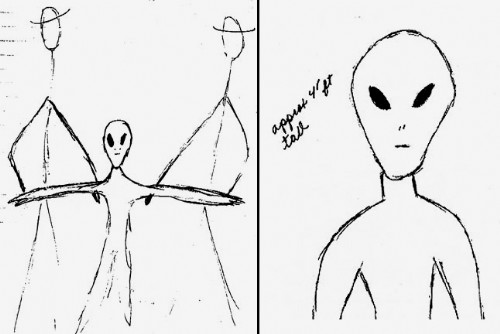the Earthly Sky
an invisible dot on an invisible dot. Infinitely small.
GARGRAVARR - The Hitchhiker's Guide to the Galaxy
![Earth - [2.24.991.Sol.3]](http://www.etsonly.com/images/earth_general/Rotating_Earth_Animation.gif)
![Sol System - [2.24.991.Sol]](http://www.etsonly.com/images/universe/002-sol-system-500.jpg)
Secondly, it's difficult because, even among those who do study or wonder about such things, no absolute reference point has been established as yet by Human science. They are only just beginning to grasp that the large-scale (3D/4D) Universe has a shape and texture to it. As for what lies beyond the EMF-observable space-time sphere or the larger framework that holds what the Humans think they see, these are just barely concepts as yet, vaguely theorized, occasionally referenced in math equations tinkered over by the more adventurous physicists, and nearly always misrepresented in / misunderstood by their news medias and educational outlets. Therefore, no yard-stick, no street signs, and no Metaverse GPS (yet: they're very close, actually, though they don't know it). It's a bit like an ant wondering around on huge nearly-featureless sphere, looking for where it is on that spehere to have some meaning.
So to put it in Human terms, the Earth is in a system of planets, planetoids, moons, asteroids...
In short, a medium, standard G-type (in human terms ["Class M" in Star Trek terms]) solar system,
almost uninhabited, young and vigorous. Of bodies with enough gravity to provide a "working surface"
this system has 100's. The Humans consider only 8 of them to be full-fledged planets, though a double
dozen of the others are quite respectable.
[MIBs: As many of you already know, of course; you're "secret" bases there-on
are not unmonitored by the MIBs, as authorized by the Earth Affairs Council. Just so you know.]
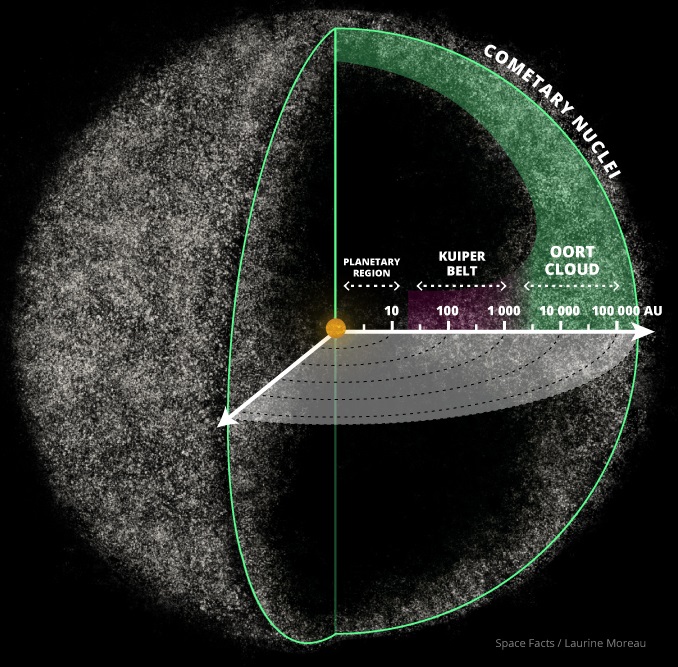
As with nearly all "raw" systems (systems not yet mined extensively or modified by the needs and desires
of motile or incarnate consciousness) it is surrounded by enough comets and such as to make up a virtual
"cell wall" around the system. Billions and billions (to not-quite quote Carl Sagan [contrary to popular Human
belief, he actually never said "billions and billions" in the Cosmos series]) of comets, ice balls,
rocky-things, abandoned scout ships, various bases, some old, some new, some incredibly old (even in
cosmic terms), and so on. Mostly it's natural stuff, still left from the original collapse / creation
of the solar system.
(Yes, it's a young system, still unbelievably full of natural resources;
but then that's one of the reasons some of you are here, yes?)
[MIB Caution: any of you thinking of pillaging this system, beware. Not only
is the full might of the Pleidian Hegemony set against you, this star itself is a feisty, cantankerous dude,
more conscious than the typical G-type star.]
An interesting footnote, the Humans (specifically, NASA) launched a pair of probes
many years ago which have just now reached beyond the Oort cloud (more or less -- it's a fuzzy sphere),
becoming the first objects that Humans have sent out into the neighborhood. In about 40,000 [Earth] years,
one of them will pass with in a light year of Gliese 445. Three other probes are on their way out of Sol System:
Pioneer 10, Pioneer 11, and New Horizons, though they are considerably behind the V'ger Probes. New
Horizons and still an active mission; the others occasionally check in with the home office to say hi.
| Voyager 1 -- launched 5 Sept 1977 | |
| Distance from the Sun | |
| Light-Time from Earth | |
| Voyager 2 -- launched 20 Aug 1977 | |
| Distance from the Sun | |
| Light-Time from Earth | |
happened with manned missions Gemini 7 & 6: NASA, both times
It took 30 years for these craft just to get from Earth to the (more or less) edge of Sol System. Though primitive technology, it is most impressive, like the [Human] ancient Egyptians crossing the Atlantic Ocean on boats made of papyrus. That it worked isn't nearly as impressive that it was even attempted.
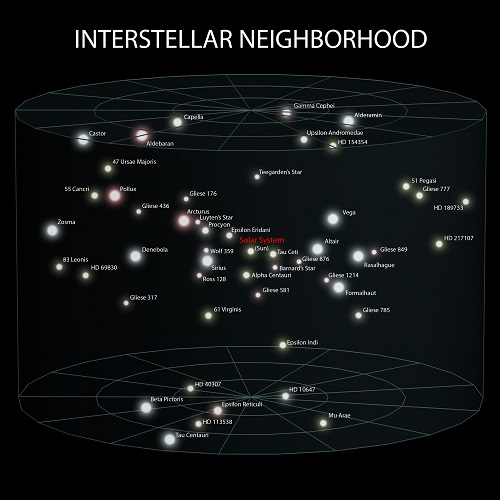
Some of us come from these nearby star systems. Some of us are from farther, even much farther away. Voyager 1 will require 40,000 (more) years to even get close to another star. Natually, one needs to travel a little faster for practical purposes. Within the next 20 - 100 years Humans will have far better engines and other propulsions methods. That still leaves the stars a very long way off for them. (So many of you can relax for a while yet.)
The Book: The Hitchhiker's Guide to the Galaxy
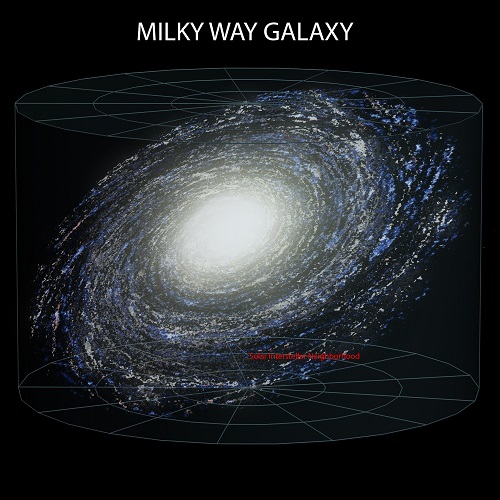
This is a fairly typical galaxy, sort of a middle class galaxy, you might say. Comfy, mediumly organized,
with a long history of its own. The current political scene, of course, has it roots going back over
3,000,000 [Earth] years ago, with such events as the Orion Wars and the Rift Dis-Settlements, and such
notable events. But then again, that too is why some of you are here, yes? The next Big Moment in the
current political thread of the galaxy might occur right here, in, on and around the Earth and
Sol System.
[MIB Note: some analysts think the Crisis might happen in as little as 6 months
(half an Earth year), others say as long yet as a thousand (Earth) years. Grab a 5D Observer and ask him,
if you can. The rest of us have to wait to actually experience it as it comes.]
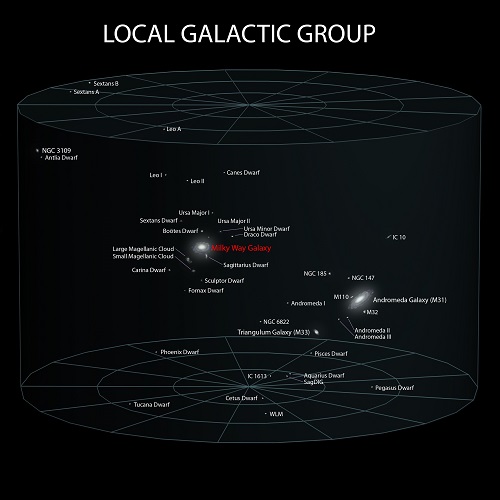
There are a fair number of galaxies that have chosen to hang out near each other in this area. Humans
have actually managed to spot most of them. (When they sort out this "dark matter" / "dark energy"
hang-up they are currently toying with, they'll find the rest of them, most likely.)
The Humans have identified some 65 galactic-sized objects in the Local Cluster. Smaller bodies (such as
unattached star clusters, even rogue stars -- trinaries, binaries and even singltons) are below the
limits of their observations at the moment, but of course out number the major bodies 1,000's to 1.
The Local Cluster is a "happening place" (another cute American-ism), with even more complex societies,
politics, histories, far larger Games and far greater scope for Intellect and Spirit and all the
implications of both.
Too tiny, too little, too insignificant against even this small collection galaxies.
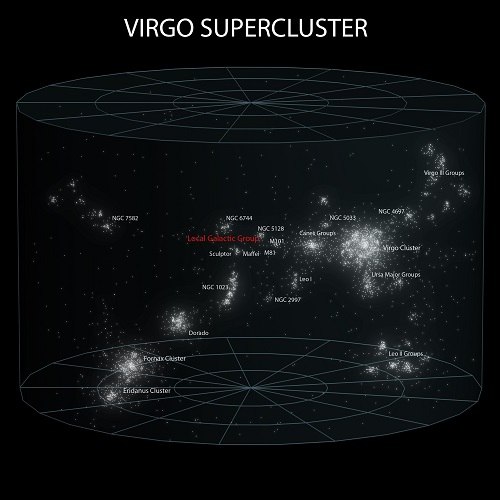
The local super-cluster is, in Human terminology, the Virgo SuperCluster, and it has a noticable shape
and texture. It is a Thing, but as yet the Humans haven't graduated to wondering why structures
form at the large scale (how yes; but why is generally called "meta physics" by
main stream Human sciences, and dismissed as invalid science. Too bad really: until you ask "why" you have
no asked no really meaningful question yet, have you?
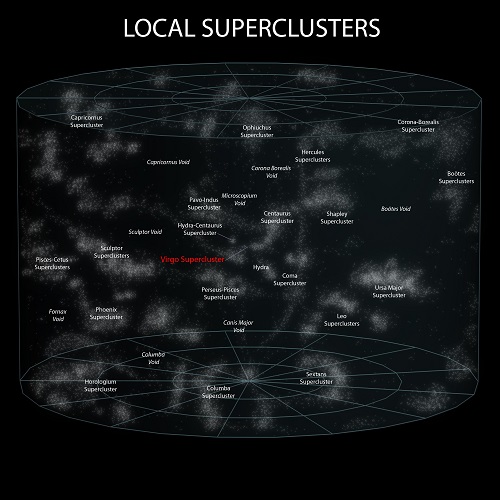
Furthermore, at this scale, one is tracking the influence of gravity rather than matter itself. Matter,
at this scale, almost doesn't... um... matter any more. These large scale structures have become
aparrent to the Humans by their watching movement, flexure of space-time, gravity lensing effects,
and so forth. By asking "why" those things were happening, they began to notice the shape of things.
![The Whole EMF-Observable Smack [as seen from Earth]](http://www.etsonly.com/images/universe/008-observable-from-earth-500.jpg)

![[Hint: compare with a slice of brain matter viewed under magnification]](http://www.etsonly.com/images/universe/super-structure-2.jpg)
Note: this is the EMF-Observable Universe, 3D/4D, as seen from Earth. "EMF-Observable," of course,
means what can seen by gathering the electromagnetic radiations that reach Earth, for both ground-based
and space-based observatories. This naturally is limited by the red-shift, caused by the apparent
distance-scaled expansion of the Universe. Until Humans discover other methods of observation (and
meaning to what they observe) they will remain limited in what they can see, and how far they can see.
Those of you who know what's beyond will find this an interesting limit, yes?
In the terms of an ancient Chinese adage: Good? Bad? Who can say?
Yes, it's true. In spite of all this wisdom gleaned painstakingly from looking very deeply and passionately
out into space, Humans really still can not say at all where they are in Space/Time. Yet they
can send space probes out into [to them] deep space. The 1⁄10 of 1% of the
Human Race, the really adventurous, really smart ones, are truly amazing, aren't they?
Of course, it's very simple ... [MIBs: contents censored as "restricted"] ...
and, therefore, the meaningful coordinates are [2.24.991.Sol] for the star (Sol) and [2.24.991.Sol.3]
for Earth itself. (Short version of the coordinates, obviously, and translated into Earth numeracy,
but it's all that most nav systems would need to get you here -- if you use that kind of transport or
translation.) For non-geometric space-time translation systems, the
[MIBs: again, contents are restricted].
This is a clue to Human psychology, that they, at the bottom line, have no location in the
Universe, no where they can point to as an absolute reference to and say, "we're so-and-so light years,
SSW, Mark 32 degrees from..." Yet, oddly, it appears to bother almost none of them. If indeed any of them.
That, too, is a clue.
does it really matter where you are?
| AU | An "astronomical unit," the (rough) distance from Earth to its primary. This of course is a variable distance, but the AU itself has been standardized at 149,597,870,700 meters |
| KM | 1,000 meters. See next |
| Meter | The meter is defined as the distance travelled by light in a vacuum in 1/299,792,458 seconds. (But... the offical Human definition fails to note a correction for that measurement being in a gravity field, or the altitude [above sea-level] within that gravity field, so it's a so-so standard.) |
| Second |
Roughly, 1⁄86,400 of a planetary [Earth] rotation. More precisely, the second is the
duration of 9,192,631,770 periods of the radiation corresponding to the transition between
the two hyperfine levels of the ground state of the caesium-133 atom. And, again, no
correction of being inside a gravity field or not. (Go figure)
Also, Earth's period of rotation about its axis is not a constant. (Again, go figure) |
| LY, Light Year |
The distance light travels in an Earth year. Slippery measurement, since Earth moves in a variety
of complex gravity fields, and also because it's time of rotation about its primary is not precise (every
time a comet grazes the inner system, Earth's period of rotation varies at least several nano-seconds),
and because Earth is actually a binary system, which introduces a "wobble" to the orbit, and many other
factors.
Still, it's defined as 9.4607 X 1012 km, a goodly distance in any measure |
| Parsec |
One parsec corresponds to the distance at which the mean radius of the earth's orbit subtends
an angle of one second of arc. (It's an Earth astronomy thing, and would take a fair amount
of diagrams and tentacle-waving to explain properly.)
That said, it amounts to 3.26 light years (3.086 X 1013 kilometers). More or less, as the primary parameter of the parsec is itself a variable (albeit a slight one). |
Reasonable approximations can be built from these. If you'd like help with translation / conversion software, feel free to ask the MIB Librarians for assistance.


